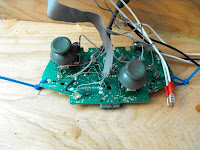In anticipation of Capcom's release of Street Fighter 4 on the PC, I decided to build a 2-player arcade console, similar to those available from X-Arcade. There are many options and choices to be made in such a project, as well as dozens of pitfalls, so I thought I'd share my experience to help inform anyone else who wants to give it a shot.
 Step 1: Defining Your Goals
Step 1: Defining Your GoalsThis is a pretty intense project, so you'll want to have a good plan from the outset. It can be costly to change your mind halfway through, so make sure you've decided as much as you can before you even get started. Some things you have to decide:
A. Which platform(s) do you want your stick to be compatible with?Are you strictly a PC/MAME gamer? If so, you will probably want an
I-PAC interface, which will make your computer see your stick(s) as a keyboard that is then easily recognized and mapped within your software. This is similar to the approach taken by X-Arcade and other PC-only arcade sticks. These control units are a mainstay of the DIY MAME cabinet crowd.
If, however, you play on a console such as the XBox 360, you might prefer doing a "pad hack" whereby you connect your arcade buttons to the circuit board inside of a console controller. This is what I chose to do because it allows me to use my sticks on my PC *and* on my friends' XBox consoles (thanks to the XBox's use of USB for their controllers). This method is a little more intense than using an I-PAC because you'll need to have a steady hand and some experience with soldering, but it's not terribly tough if you take it slow and exercise some care.
B. Which hardware do you want to use?When it comes to arcade hardware, one size does not fit all. There is incredible diversity among sticks and buttons that varies by manufacturer, region (Japan vs America) and games that are intended to be played. For example, many competitive Street Fighter players prefer (to put it mildly) Japanese-style sticks (especially Sanwa), while Pac Man pros usually opt for ball-top American-style sticks. Furthermore, Street Fighters usually choose Japanese-style buttons, which are convex and have a shorter throw compared with American-style buttons. I recommend doing your homework and clocking in some time with a few different sticks before you make your choice because it's totally up to individual preference.
I grew up using Happ bat-top sticks and Happ's clicky, concave buttons in the local arcade, so that's what I went with. I purchased them from Tornado Terry on eBay at a really great price.
C. What kind of button layout will you use?The button layout is almost as personal and important as the hardware selection, so again, you'll want to do your homework and try out a few things before making any major moves. Some prominent stick-makers are using an eight-button layout with four buttons in two rows (as in the Mad Catz Tournament Edition stick), but I often get lost on this configuration and end up accidentally scooting over to the wrong buttons during the more heated moments.
Again, Japanese- and American-style button layouts differ, with Japanese-style layouts having a staggered positioning that mimics the way your fingers naturally fall, while American-style layouts are straight across.
Slagcoin.com has a pretty great collection of sample layouts that you can use or you can modify one of them to create a unique layout that's all your own, which is what I did:

(since I modified it, the measurements may not all be accurate, so you're probably better off printing it out and working directly with the template if you plan to use this one)
I went with a Japanese-style stagger because I find it to be more ergonomic. Additionally, since I emulate a lot of Neo Geo games, I wanted to have four buttons in one of the rows to recreate that feel but not on both rows to avoid confusion. This fourth button in the bottom row also works perfectly as the 'run' button in certain Mortal Kombat games.
D. What materials do you want to construct your stick out of?This is where you can really put a visible, personal touch on your creation and make something that is instantly identifiable. Arcade sticks are pretty much just boxes that you screw things to, so you can build a box from scratch using high- or low-quality materials, or you can repurpose a box from somewhere else to give your stick a "found materials" kind of look. I won't delve too deeply into this aspect of the construction process since I'm a shitty carpenter and you can definitely find more complete and informative guides to box-building elsewhere online.
I wanted something large, sturdy and attractive enough to leave in my living room, so I opted for a combination of red oak top and two sides paired with high-quality plywood (from the 'project' section of Lowe's, not that splintery shit from the lumber section) for the bottom and other sides. I then stained it with a dark stain and covered it with several coats of shellac, which made it look like an antique piece of furniture.

It didn't turn out perfectly due to my aforementioned shitty carpentry skills, but it passed the wife test so it's good enough for me.
Page 1: Building an Arcade-style Fight Stick
Page 2: Assembling Your BoxPage 3: Pad HackingPage 4: Installing the HardwarePage 5: Conclusions and Helpful Links




















